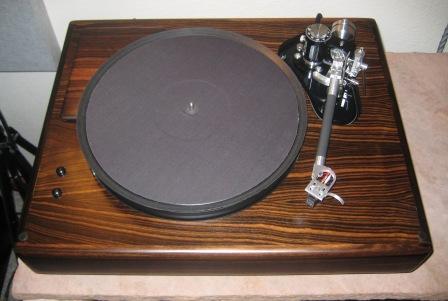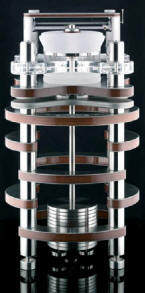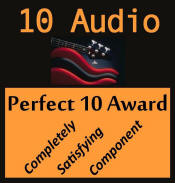I have to tell you that I have been putting off writing this review for months. Stalling, actually. It is not because I was faced with the unpleasant chore of writing a review about a poorly performing product. Writing one of those is something that just does not motivate me to spend a day or more writing and editing a review. The delay was for two good reasons:
- Here is a typical auditory chain of events when auditioning a new component: (a) within the first few minutes – hear the gross differences to what the new component replaced; (b) enjoy whatever advantages the new component has; (c) begin to hear the real faults in the new component; and finally, often as soon as 2-3 hours into the audition (d) begin to decide if those faults are tolerable. For almost 9 months, I have been stuck on (b).
- Each time I planned to write this review, I went into my listening room, which is next to my office, and put on a record. And sat down. So much for self-imposed deadlines and self-discipline.
 The review system included a Kuzma Stabi Reference turntable; Origin Live Conqueror and TriPlanar VII tonearms; Koetsu Jade Platinum, ZYX UNIverse, and Benz LP phono cartridges; Conrad Johnson Premier 15 Series 2, EAR 88PB, Audio Horizons TP8.0cMCpn, and Manley Steelhead phono preamplifiers; Placette Passive and Active, Dodd Battery Powered, and ModWright SWLP 9.0SE preamplifiers; Response Audio Bella EXtreme 100, Bel Canto S300, and Manley Neo-Classic 250 power amplifiers; Gallo Reference 3.1 or Spendor S5e (from the HT system) speakers, often used with my Perfect Subwoofers. Interconnects were almost exclusively PS Audio Resolution Transcendent RCA, and speaker cables were Audience Au24.
The review system included a Kuzma Stabi Reference turntable; Origin Live Conqueror and TriPlanar VII tonearms; Koetsu Jade Platinum, ZYX UNIverse, and Benz LP phono cartridges; Conrad Johnson Premier 15 Series 2, EAR 88PB, Audio Horizons TP8.0cMCpn, and Manley Steelhead phono preamplifiers; Placette Passive and Active, Dodd Battery Powered, and ModWright SWLP 9.0SE preamplifiers; Response Audio Bella EXtreme 100, Bel Canto S300, and Manley Neo-Classic 250 power amplifiers; Gallo Reference 3.1 or Spendor S5e (from the HT system) speakers, often used with my Perfect Subwoofers. Interconnects were almost exclusively PS Audio Resolution Transcendent RCA, and speaker cables were Audience Au24.
To keep variables to a minimum, I started with the Conqueror arm and ZYX cartridge, which I had been enjoying together for several months on the $8000 Kuzma Stabi Reference table. The Kuzma had supported all of my listening for more than two years, which is a long time for any piece of gear to remain in my system. The record is nine years for a Well Tempered Reference turntable, in case someone keeps track of this stuff. I moved the Conqueror to the factory-drilled and balanced Cosmos armboard, reset the geometry so it matched what was set for the Kuzma, and put on a record.
Let me take a step back for a couple of minutes and give you a little history on this review. The first “real” turntable I owned was an original, gold-platter Sota Sapphire, circa 1981. Its spongy springs and similarly spongy – full and warm – but deep and potent bass, excellent imaging, and clear highs were a revelation at the time. Each time I changed turntables over the next 24 years, I always recalled the enjoyment I got from that old Sapphire. The company changed ownership about 10 years ago, and it is now owned and operated by Donna and Kirk Bodinet. Both were very helpful and kind as I tried to make up my mind about which wood I preferred. Their support when I had an early question or two was all that a consumer of luxury goods could ever ask for. I ordered the Cosmos turntable, which lists for about $6900 with pre-cut armboard and dust cover, and not-too-patiently awaited delivery during the 4-5 week expected lead time.
And then there was UPS.
The table and vacuum unit shipped on December 22, 2006. I thought, in an optimistic but typically audiophile way that it would arrive for Christmas. But, Noooooo, as Steve Martin used to say. Delay, delay, delay. Holiday delay. Certainly the week after! Weird and unexplained but typical UPS lost-in-the-twilight-zone delay. Then a snowstorm delay, which “closed” Colorado for three days. It finally arrived on January 5, 2007.
The cherry wood turntable and matching vacuum unit looked beautiful. Kirk is a cabinet maker and his turntables reflect his high level of craftsmanship. I noticed that the suspended chassis did not have the spongy feel that I remembered from the Sapphire. It is quite firm while still allowing the required movement to provide isolation from the supporting structure. Set-up was straight forward, guided step-by-step by the included instructions. About 2 hours elapsed from box opener to lowering the cuing lever on the first LP.
Going with my auditory chain-of-events above, the first thing I noticed when transitioning from the Stabi Reference was the difference in the character of the bass. The difference was large (immediately noticeable). There seemed to less of it. Less of the rolling-thunder, wash-over-me, shake-the-floor bass that is an inherent character of the Kuzma and many other turntables. The Cosmos provided far, FAR more bass detail and resolution, like you would enjoy from a fine SET amp in the midrange. My immediate impression was that the Cosmos did not offer the low bass extension of the Kuzma, but this was not a correct impression. As a result of having much better bass definition with less overhang, the bass did not have the fullness of the Kuzma nor as much total bass energy. Instead, each bass note was a separate entity which stood out in stark relief from other notes. The low bass extension was still present, but without the extra “halo” that other turntables add. The benefit is not just tighter bass, but a faultless transition to the upper bass and lower midrange, which share this high resolution character.
No, time out. That phrase, “transition to the upper bass and lower midrange” is a misguided concept. There is no “transition” in this area any more than there is a “transition” from the lower midrange to the middle-midrange or from the midrange to the upper midrange. A transition could be defined as a change in the character of the sound going from one frequency range to another. The whole concept is, after hearing the Cosmos, based on the misrepresentation of the bass range by other turntables. By every other turntable I can recall, in fact, to one degree or another. Continuing this thought, if there also seems to be a bass-midrange transition from another source, such as CD, then I suggest that there is a problem in your “bass system”. This includes your amplifier’s ability to competently drive your speakers’ increasing power demands in the lower frequencies, the speakers themselves – including the woofer-midrange crossover, and your room. OK, time in again.
Even on regular commercial pressings, it is often easy to hear not only the pedal’s impact on the bass drum head, but the additional sound from the other head, following a tiny fraction of a second later. Very enjoyable! Each vibration of a string on an acoustic bass is obvious, but without missing the musical intent. Bass guitar runs up and down the scale are amazingly coherent and flowing. The bass of the Cosmos is a vast improvement over the Kuzma and significantly narrows the gap to live sound. This entire review could focus on the exceptional bass performance of the Cosmos, which is reason enough to replace whatever turntable you own. Which I did. But don’t be concerned: the rest of the audible frequency range is equally well served, although not as dramatically improved.
The continuity from bass to midrange is perfectly seamless, such that the distinction is meaningless when listening to music. The sound simply flows. Listening to The Nylons, a four-part a cappella group with percussion instruments only, the bass singer is fully developed and his voice is present to an amazing degree, whether singing at the bottom of his range or into the alto. Other singers, on this or other LPs, have lifelike body and also lifelike separation. Minor differences in stage location are clearly audible while preserving the depth and 3-D quality of living performers. There is a bit less of the sense of individual rows upon rows of musicians in large scale orchestras, but the image of a deep, continuous stage is very convincing and closer to what I hear in a live performance. This was much more apparent when the extremely articulate TriPlanar tonearm was installed in place of the Conqueror.
Up top, in the treble, is where any problems with turntable wow or flutter would be obvious. None were. And I was frankly surprised at this. You have probably seen turntables with massive platters, some weighing upwards of 25 or even 50 kilos, which take a long time to coast to a stop due to their huge moment of inertia. The purpose, of course, is to add mass and keep rotational speed constant while discouraging minute vibrations. The “individually balanced 12 lb one-piece cast platter with internal damping, lead flywheel ring, SOTA Vinyl Format Platter Mat, molded silicone vacuum lip and anti-static Groove Damper Mat ” perform this same function exceptionally well. The Reflex clamp doesn’t seem to affect the sound to any significant degree, but using it helps the platter to achieve a quick vacuum seal.
Still dubious after listening carefully for any warbling or other indications of speed variations, I connected both my Tektronix 50 mHz oscilloscope and a 5 mHz frequency counter. I experimented with sine waves at 100 Hz and 1 kHz, each for 3 minutes. The scope showed a stable waveform, while the frequency maintained -0 +1 Hz consistency, varying slowly over 15-20 seconds when it changed at all which was maybe one time during the 3 minute period. Anyone would hear this as an extremely steady tone. This variation could have been caused by variations in the local power grid, although the Sota’s synthesized-waveform AC stepper motor with outboard power supply (contained in the vacuum enclosure) should mitigate external electrical problems. The changing indication on the frequency counter could also be circuit drift or normal tolerance in the counter itself. I heard no changes in the test tones.
It is worth mentioning that the Cosmos has a user-adjustable speed control, found at the rear of the turntable where the power cable and vacuum hose connect. This control may benefit from a very minor adjustment every couple of months to maintain dead-nuts speed accuracy.
I was leery of the vacuum feature, although the reported benefits would be very welcome. “Leery” because I want my listening to be “nice and easy”, not “nice and rough” as Tina Turner sings. I do not appreciate complexity of operation. The benefit of vacuum clamping: Briefly, if the LP is “locked” in direct contact with a surface which is able to eliminate resonances in the vinyl, it would be the perfect turntable platter. Even though we use a millivolt scale to rate the output of a cartridge, the fine detail of music has much less voltage. Think in terms of microvolts, were a spoken whisper might be only 200 millionths of a volt – only 20 dB down from fairly LOUD. If the LP is resonating – which means vibrating, which means moving – it will, sure as a retip, distort the sound you hear. Without vacuum, we would need both a center clamp and something to hold down the outer edge, such as VPI’s edge ring. Even then, the entire groovy area of the LP might not have a solid contact with the surface of the platter. It was not possible for me to test the audible effectiveness of the vacuum due to the raised lip of pliant silicone rubber which creates the vacuum seal around the record’s outer edge. The lip raises the LP’s edge slightly off of the platter before the vacuum is turned on.
 And speaking of being turned on, you don’t have to. There are only two rounded buttons at your command: a 33-45 speed selector and one button for on-off. Push the on-off. The platter turns and the vacuum pump starts. In the time it takes to use a record cleaning brush – 3 to 5 revolutions – the vacuum has clamped the record firmly to the platter and the pump has automatically shifted into quiet mode. It is still audible from several feet away as a low rumble, but the sound is obscured by any music and I have never been aware of or bothered by it while listening to music. When the record is done playing, push the on-off button again. The pump turns off and the platter stops in less than one revolution. As you move to hold the edge of the LP to take it off of the platter, you will push down on the outer vacuum lip and break the suction. The vacuum works, it requires no extra effort on your part, and it was completely reliable during more than eight months of regular use.
And speaking of being turned on, you don’t have to. There are only two rounded buttons at your command: a 33-45 speed selector and one button for on-off. Push the on-off. The platter turns and the vacuum pump starts. In the time it takes to use a record cleaning brush – 3 to 5 revolutions – the vacuum has clamped the record firmly to the platter and the pump has automatically shifted into quiet mode. It is still audible from several feet away as a low rumble, but the sound is obscured by any music and I have never been aware of or bothered by it while listening to music. When the record is done playing, push the on-off button again. The pump turns off and the platter stops in less than one revolution. As you move to hold the edge of the LP to take it off of the platter, you will push down on the outer vacuum lip and break the suction. The vacuum works, it requires no extra effort on your part, and it was completely reliable during more than eight months of regular use.
Appearance. If the thought of owning a Clearaudio Statement makes your heart beat faster, you may think Sota tables are just plain boring looking. The Cosmos’ rectangular wood body, matching raised pulley cover and vacuum enclosure most certainly fall closer to the “understated” class than the über techno Clearaudio, all clear acrylic and polished stainless and such. And in fact, I was a bit underwhelmed with the Cosmos dressed in cherry wood. The Cosmos I have now is in Macassar Ebony, which is elegant, bold, and stunning. Eye candy for the cardigan crowd. Or, maybe yours.
Inside, the damped aluminum honeycomb plinth, tuned springs, electronic speed control, vacuum hold down, and adjustable cone feet all result in an analog turntable of the highest audio quality. There is a built-in upgrade path from the $2400 Sapphire, now in Series V, to the Cosmos and even to the $8680 Millennia. The Millennia dispenses with the wood body and exposes the honeycomb platform, moving it decisively towards the techno camp.
The Cosmos may be a relative late comer, but the design has been maturing for over a quarter of a century with the experience of making thousands of turntables. After two years enjoying a Stabi Reference, it was quickly apparent that the Sota Cosmos is sonically superior and closes the gap with the sound of live music. I feel as though I have come full circle. That old Sapphire is still a fond memory, but this new Cosmos is technically refined, beautiful to see and use, and performs spectacularly. I don’t plan to make the same mistake again by selling my Sota. This one may be the last turntable I own.
Overall Rating: 10 LPs

Link to Sota Turntables
